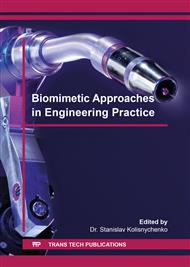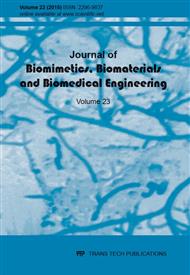[1]
Moore A R, Lowson M V. Drag reduction in a rectangular duct using riblets. Aeronautical Journal, 1995, 99(985), pp.187-193.
DOI: 10.1017/s0001924000028360
Google Scholar
[2]
Pan G, Guo X J, Hu H B. Numerical simulation of semicircular traveling wave surface and study on its drag-reduction mechanism. Journal of System Simulation, 2006, 18(11), pp.3073-3094.
Google Scholar
[3]
Koeltzsch K, Dinkelacker A, Grundmann R. Flow over convergent and divergent wall riblets. Experiments in Fluids, 2002, 33(2), pp.346-350.
DOI: 10.1007/s00348-002-0446-3
Google Scholar
[4]
Gu Y Q. Drag reduction characteristics of bionic jet surface. Harbin: Harbin Engineering University, College of Mechanical and Electrical Engineering, (2013).
Google Scholar
[5]
Lu Y X. Significance and progress of bionics. Journal of Bionics Engineering, 2004, 1(1), pp.1-3.
Google Scholar
[6]
Cong Q, Ren L Q, Wu L K, Chen B C, Li A G, Hu A L. Taxonomic research on geometric nonsmooth animal surface shapes. Transactions of the Chinese Society of Agricultural Engineering, 1992, 8(2), pp.7-12.
Google Scholar
[7]
Tong J, Ren L Q, Chen B C.Geometrical morphology, chemical constitution and wettability of body surfaces of soil animals. International Agricultural Engineering Journal, 1994, 3(1&2), pp.59-68.
Google Scholar
[8]
Liu G M, Li J Q, Tian X M, Zou M, Li Y W. Experiment on reduction of soil adhesion force and sliding resistance of earthworm non-smooth surface. Journal of Agricultural Machinery, 2008, 39(9), pp.138-143.
Google Scholar
[9]
Cai M, Cui X C, Wang L, Li B, Nie S Q. Numerical study of uniform flow over golf ball. Mechanics in Engineering, 2011, 33(3), pp.63-66.
Google Scholar
[10]
Bearman P W, Harvey J K. Control of circular cylinder flow by the use of dimples. AIAA Journal, 1993, 31(10), pp.1753-1756.
DOI: 10.2514/3.11844
Google Scholar
[11]
Ren L Q, Cong Q, Tong J, Chen B C. Reducing adhesion of soil against loadingshovel using bionic electro-osmosis method. Journal of Terramechanics, 2001, 38(4), pp.211-219.
DOI: 10.1016/s0022-4898(01)00002-7
Google Scholar
[12]
Zhang C C, Ren L Q, Wang J, Zhang Y Z. Simulation on flow control for drag reduction of revolution body using bionic dimpled surface. Acta Armamentarii, 2009, 30(8), pp.1066-1072.
Google Scholar
[13]
Gu Y Q, Zhao G, Liu H, Wang Y M, Li Z Y, Liu W B, Zhao J Y, Li F. Characteristics of drag reduction of bionic dimpled surface of shell rubber ring of aerodynamic extinguishing cannon. Journal of Jilin University: Engineering and Technology Edition, 2013, 43(4), pp.983-990.
DOI: 10.1007/s11771-013-1830-2
Google Scholar
[14]
Bechert D W, Bruse M, Hage W. Experiments with three-dimensional riblets as an idealized model of shark skin. Experiments in Fluids, 2000, 28(5), pp.403-412.
DOI: 10.1007/s003480050400
Google Scholar
[15]
Wang J J, Lan S L, Chen G. Experimental study on the turbulent boundary layer. Fluid Dynamics Research, 2000, 27(4), pp.217-219.
Google Scholar
[16]
Walsh M J. Riblets in viscous drag reduction in boundary layers. Progress in Astronautics and Aeronautics, 1990, 123, pp.203-61.
DOI: 10.2514/5.9781600865978.0203.0261
Google Scholar
[17]
Viswanath P R. Aircraft viscous drag reduction using riblets. Progress in Aerospace Sciences, 2002, 38(6), pp.571-600.
DOI: 10.1016/s0376-0421(02)00048-9
Google Scholar
[18]
Bechert D W, Bruse M, Hage W, Meyer R. Fluid mechanics of biological surfaces and their technological application. Naturwissenschaften, 2000, 87(4), pp.157-171.
DOI: 10.1007/s001140050696
Google Scholar
[19]
Bechert D W, Bruse M, Hage W. Experiments with three-dimensional riblets as an idealized model of shark skin. Experiments in Fluids, 2000, 28(5), pp.403-412.
DOI: 10.1007/s003480050400
Google Scholar
[20]
Lee S J, Jang Y G. Control of flow around a NACA0012 airfoil with a micro-riblet film. Journal of Fluids and Structures, 2005, 20(5), pp.659-672.
DOI: 10.1016/j.jfluidstructs.2005.03.003
Google Scholar
[21]
Konovalov S F, Lashkov Yu A, Mikhailow V V. Effect of longitudinal riblets on the aerodynamic characteristics of a straight wing. Fluids Dynamics, 1995, 30(2), pp.183-187.
DOI: 10.1007/bf02029827
Google Scholar
[22]
Sanders R, Rushall B, Toussaint H M, Stager J, Takagi H. Bodysuit yourself, but first think about it. American Swimming Magazine, 2001, 5, pp.23-32.
Google Scholar
[23]
Park S R, Wallace J M. Flow alteration and drag reduction by riblets in a turbulent boundary layer. AIAA Journal, 1994, 32(1), pp.31-38.
DOI: 10.2514/3.11947
Google Scholar
[24]
Han X, Zhang D Y. Study on the micro-replication of shark skin. Science in China: Series E, 2008, 51(7), pp.890-896.
DOI: 10.1007/s11431-008-0080-2
Google Scholar
[25]
Han X, Zhang D Y. Replication of shark skin based on micro-electroforming. Journal of Agricultural Machinery, 2011, 42(2), pp.229-234.
Google Scholar
[26]
Cong Q, Feng Y, Ren L Q. Affecting of riblets shape of nonsmooth surface on drag reduction. Journal of Hydrodynamics, 2006, 21(2), pp.232-238.
Google Scholar
[27]
Liu Z H, Dong W C, Xia F. The effects of the tip shape of V-groove on drag reduction and flow field characteristics by numerical analysis. Journal of Hydrodynamics, 2006, 21(2), pp.223-231.
Google Scholar
[28]
Li X H, Dong S P, Zhao Z Y. Experimental study on Reynolds shear stress in turbulent boundary layers over smooth and drag reduction grooved surface. Journal of Experiments in Fluid Mechanics, 2006, 20(1), pp.40-44.
Google Scholar
[29]
Tian L M, Ren L Q, Liu Q P, Zhao G R. Numerical simulation on drag reduction characteristic around bodies of revolution with bionic non-smooth surface. Journal of Jilin University: Engineering and Technology Edition, 2006, 36(6), pp.909-913.
Google Scholar
[30]
Zhao G, Zhao H L, Shu H S, Zhao D, Gu Y Q, Xia D L. Simulation study of bionic jetting direction influence on drag reduction effect. Advances in Natural Science, 2010, 3(2), pp.17-26.
Google Scholar
[31]
Gu Y Q, Zhao G, Zhao H L, Zheng J X, Wang F, Xiao L, Liu W B. Simulation study on drag reduction characteristics of bionic jet flow based on shark gill. Acta Armamentarii, 2012, 33(10), pp.1230-1236.
Google Scholar
[32]
Gu Y Q, Zhao Gang, Zheng J X, Zhang S, Ru J, Liu M M, Yao J J. Drag reduction characteristics on jetting surface with jet angle-jet velocity coupling. Journal of Xi'an Jiaotong University, 2012, 46(9), pp.71-77.
Google Scholar
[33]
Gu Y Q, Zhao G, Zheng J X, Wang F, Li Z Y, Liu W B, Zhao H X. Characteristics of drag reduction on coupling of jet surface main flow field velocity and jet velocity. Journal of Central South University: Science and Technology, 2012, 43(12), pp.4713-4721.
Google Scholar
[34]
Zhao G, GU Y Q, Zhao H L, Xia D L, Yao J J. Numerical simulation of the drag reduction characteristics of a bionic jet surface aperture coupled with jet speed. Journal of Harbin Engineering University, 2012, 33(8), pp.1001-1007.
Google Scholar
[35]
Gu Y Q, Mu J G, Zhao G, Wang F. Modeling of drag reduction test system of jet surface and experimental study on drag reduction characteristics. Journal of Huazhong University of Science of Technology: Natural Science Edition, 2014, 42(6), pp.22-27.
Google Scholar
[36]
Gu Y Q, Mu J Q, Zheng S H, Zhao G. Experimental analysis on drag reduction characteristics of jet hole diamond arrangement for jet surface. Journal of Huazhong University of Science of Technology: Natural Science Edition, 2015, 43(1), pp.16-20.
Google Scholar
[37]
Gu Y Q, Mou J G, Dai D S, Zheng S H, Jiang L F, Wu D H, Ren Y, Liu F Q. Characteristics on drag reduction of bionic jet surface based on earthworm's back orifice jet. Acta Physica Sinica, 2015, 64(2), p.024701.
DOI: 10.7498/aps.64.024701
Google Scholar
[38]
Gu Y Q, Zhao G, Zheng J X, Li Z Y, Liu W B, Muhammad F K. Experimental and numerical investigation on drag reduction of non-smooth bionic jet surface. Ocean Engineering, 2014, 81, pp.50-57.
DOI: 10.1016/j.oceaneng.2014.02.015
Google Scholar



